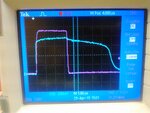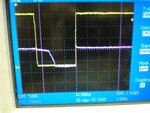deepakchikane
Full Member level 3
- Joined
- Jul 17, 2012
- Messages
- 178
- Helped
- 2
- Reputation
- 4
- Reaction score
- 2
- Trophy points
- 1,298
- Location
- Mumbai, Maharashtra, India, India
- Activity points
- 2,623
Hi all,
i would like to know the operating frequency of BD 139.
I am generating 30 khz signal from a controller & driving a bjt bd 139 for current amplification purpose.
i have biased the bd 139 to maintain a voltage between B-E terminals.
but the bd 139 is giving a signal for more time than actual controller signal.
datasheet:https://www.st.com/web/en/resource/technical/document/datasheet/CD00001225.pdf
check the attached image
1) pink is the waveform from controller.(5v)
2) Blue waveform is at the actual bjt pin (gnd to base of bd 139)
biasing resistor is 400 ohms.
i would like to know the operating frequency of BD 139.
I am generating 30 khz signal from a controller & driving a bjt bd 139 for current amplification purpose.
i have biased the bd 139 to maintain a voltage between B-E terminals.
but the bd 139 is giving a signal for more time than actual controller signal.
datasheet:https://www.st.com/web/en/resource/technical/document/datasheet/CD00001225.pdf
check the attached image
1) pink is the waveform from controller.(5v)
2) Blue waveform is at the actual bjt pin (gnd to base of bd 139)
biasing resistor is 400 ohms.






